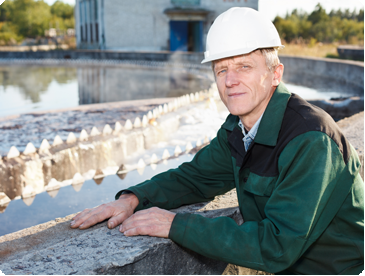

Aqua Diagnostic Pty Ltd, a Melbourne SME producing advanced water quality monitoring equipment and consumables for measuring chemical oxygen demand (COD), used the Australian Synchrotron to enhance the quality of its proprietary nanotechnology PeCOD® sensors through increased understanding of its manufacturing process.
The Synchrotron findings have assisted the company’s plans to scale up to higher volumes in response to expected global demand as it expands its share of the international COD measurement market valued at more than $100 million.
Conventional COD tests involve time-consuming and inherently hazardous procedures and highly toxic components such as mercury and chromic acid. By contrast, the Aqua Diagnostic PeCOD® method takes just minutes and the ecofriendly byproducts can be safely tipped down the sink.
The Synchrotron will continue to assist development of the PeCOD® sensors by revealing how manufacturing conditions influence their nanoscale phase structure. The Canadian State of Ontario recently gave the product its first independent method approval, and Aqua Diagnostic anticipates receiving regulatory approval for the PeCOD® method in many more international jurisdictions in the coming few years, underpinning its great potential for global expansion.
Coalbridge – air monitoring system validation

The Infrared Microscope at the Australian Synchrotron - with its ability to thoroughly ‘fingerprint’ tiny specks of natural and artificial materials - is providing a valuable ‘second opinion’ to help validate a new air monitoring system for microscopic coal particles.
For more than 25 years, Coalbridge has been providing specialist services to the coal industry, including advising on environmental monitoring and management.
The issue of dust resulting from activities such as coal mining and transport has received a lot of public attention. The particles that generate the most concern are those too small to be naturally expelled from the lungs.
In a recent collaboration with the CSIRO Energy Flagship, Coalbridge has been applying the CSIRO Coal Grain Analysis (CGA) system for efficiently monitoring air particulates. This utilizes a high-resolution optical system that can be ‘trained’ to discriminate between microscopic coal particles and other particulates like mineral dust, rubber, soot from car exhaust or even plant fragments. The Synchrotron's capabilities are helping validate the system's accuracy.
Preventing heavy rail failure: Institute of Rail Technology

The overwhelming majority of iron ore and coal for export is transported on heavy haul rail systems. New steel alloys for both rails and wheels are being developed to allow for even higher loads to improve the network efficiency and the bottom line of these operations.
However, the higher alloy content in these steels can lead to issues with welding of the rails, and pose a substantial safety risk. A derailment can cost tens of millions of dollars in lost production.
The Institute for Rail Technology (IRT) at Monash University, which has BHP Billiton, Rio Tinto, FMG and Vale (four of the largest iron ore producers) as clients, is investigating with the Australian Synchrotron how the uneven distribution of elements such as manganese affects the reliability of welded rails, enabling better prediction of failure.
X-ray Fluorescence Microscopy can be used to study single biological cells - or help us understand how to avoid failures of heavy steel rail weld under massive loads.
Nanoengineering bionic vision technology

MiniFAB, an industrial participant in the Monash Vision Group*, have a key role in the development of an implant that provides electrical interface between the output of a CCD camera and the human brain.
Integral to this effort is the development of micro-electrodes capable of long term implantation into the brain, yet fine enough to cause minimal tissue damage.
Microbeam crystallography at the Australian Synchrotron has allowed the detailed atomic structure to be studied around the tips of these electrodes – before and after processing steps. This information has been invaluable in predicting the performance of different metal alloys and shortening the manufacturing development cycle.
* Supported by the ARC Special Research Initiative on Bionic Vision
Tracking down micro-contaminants

Infrared microscopy is an excellent way of identifying small amounts of organic material.
Memjet manufactures a printer head with more than 70,400 jets which dramatically increase print speed.
For the micro-nozzles on the Memjet’s revolutionary print head, specks of contaminant much smaller than even the width of a human hair can be important, but regular infrared microscopes have trouble measuring such miniscule specimens.
The Australian Synchrotron has been the key to providing sufficient brilliance of illumination to positively identify these smallest particles and help track down their source.
High resolution for big industry - Worsley

BHP Billiton Worsley Alumina (Worsley) has been mining bauxite and refining alumina in Western Australia for more than 30 years.
Some of its processes involve extensive materials research, in particular the use of an x-ray based technique called ‘powder diffraction’.
To leverage the maximum value from its own data, the Worsley research team has applied very high resolution data measured at the Australian Synchrotron.
Worsley’s own research and the advanced capabilities of the Australian Synchrotron are helping Worsley to become a more efficient and sustainable business.
Helping make medicines more affordable

When a popular medicine goes ‘off-patent’ it allows other companies to legally make the product more competitively.
What is less well known is the amount of scientific research that must be done to produce a ‘generic’ version of the drug.
While a generic drug is more affordable than the ‘name’ brand it must also be just as effective – and manufactured to the highest safety standards.
Hospira ANZ employs more than 650 people in Mulgrave, Victoria – a highly skilled workforce manufacturing high-quality generic injectable medicines. They export more than $280 million worth of product from this site annually.
Hospira’s access to the world-class instrumentation and expertise at the Australian Synchrotron is enhancing their ongoing industrial research – research that keeps them competitive on a world stage.
